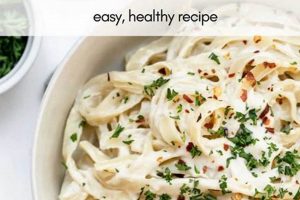A plant-based alternative to traditional dairy-laden condiments, this preparation offers a rich and savory flavor profile. It achieves its characteristic texture through the blending of ingredients such as cashews, silken tofu, or sunflower seeds, combined with garlic, lemon juice, and nutritional yeast for a cheesy, umami note. It exemplifies the creative adaptation of culinary techniques to accommodate dietary restrictions and preferences.
This particular style of sauce addresses the growing demand for animal-product-free options without sacrificing taste or textural satisfaction. Its versatility allows it to be used as a dip, a topping for pasta or vegetables, or as a flavorful addition to sandwiches and wraps. This culinary innovation reflects a broader trend towards sustainable and ethical food choices, providing individuals with a means to enjoy familiar flavors while adhering to their chosen lifestyle.
The following sections will explore various methods for creating this delicious sauce, detailing the specific ingredients and techniques that contribute to its unique character. Subsequent discussions will also cover potential variations and pairings, offering a complete guide to incorporating this versatile condiment into a range of meals.
Tips for Crafting a Superior Vegan Creamy Garlic Sauce
Achieving optimal flavor and texture in a plant-based garlic sauce requires careful attention to ingredient selection and preparation techniques. The following tips are designed to enhance the culinary outcome.
Tip 1: Employ raw cashews, soaked in hot water for at least 30 minutes, to ensure a smooth and creamy consistency. Prolonged soaking facilitates easier blending and eliminates any residual grittiness.
Tip 2: Nutritional yeast is paramount for replicating the savory, umami notes typically associated with dairy-based sauces. Experiment with different brands to find a flavor profile that aligns with personal preferences.
Tip 3: Lemon juice serves a dual purpose: it brightens the overall flavor and acts as a natural preservative. Freshly squeezed juice is preferred over bottled varieties for optimal taste.
Tip 4: Garlic can be incorporated raw, roasted, or sauted depending on the desired intensity. Roasting or sauting mellows the sharpness and imparts a subtly sweet undertone.
Tip 5: Adjust the liquid content incrementally. Begin with a minimal amount of plant-based milk or water and gradually add more until the desired consistency is achieved. This prevents an overly thin sauce.
Tip 6: For enhanced richness, consider incorporating a small amount of extra virgin olive oil. High-quality oil contributes both flavor and a luxurious mouthfeel.
Tip 7: Do not neglect seasoning. Salt and pepper are essential, but additional spices such as onion powder or smoked paprika can add depth and complexity.
Adhering to these guidelines will facilitate the creation of a flavorful and satisfying plant-based garlic sauce suitable for a variety of culinary applications.
The subsequent section will delve into potential variations, offering further opportunities for personalization and culinary exploration.
1. Texture
Texture is a paramount characteristic of a successful plant-based garlic sauce, significantly influencing its palatability and overall appeal. Achieving a smooth, creamy consistency is essential for replicating the luxurious mouthfeel of traditional dairy-based counterparts. The method of ingredient preparation and blending directly impacts the final result.
- Ingredient Hydration
Proper hydration of base ingredients, such as cashews or sunflower seeds, is fundamental. Soaking these ingredients in hot water for a sufficient duration softens them, facilitating seamless blending and preventing a grainy texture. Insufficient hydration results in a less refined final product. For example, cashews soaked overnight are substantially easier to blend to a smooth consistency than those soaked for only a few minutes.
- Blending Technique
The blending process itself plays a critical role. Utilizing a high-powered blender is advantageous, as it possesses the capacity to pulverize ingredients more effectively. Employing lower speeds or insufficient blending time can leave undesirable particles, compromising the smoothness. Regularly scraping down the sides of the blender container ensures that all ingredients are fully incorporated and evenly processed.
- Liquid Ratio Management
The ratio of liquid to solid components directly influences the sauce’s thickness and viscosity. Adding liquid incrementally while blending allows for precise control over the final texture. An excess of liquid results in a thin, watery sauce, while insufficient liquid yields an overly thick or pasty consistency. Careful adjustment is necessary to strike the optimal balance. The type of liquid used, such as plant-based milk or water, also influences the final texture.
- Fat Content and Emulsification
The fat content, derived from ingredients like cashews or olive oil, contributes significantly to the sauce’s perceived creaminess. The emulsification process, facilitated by blending, ensures that these fats are evenly distributed throughout the sauce, preventing separation and enhancing the overall smoothness. Stable emulsification is critical for maintaining a homogenous texture during storage.
Therefore, achieving a desirable texture in plant-based garlic sauce requires a multifaceted approach, encompassing careful ingredient preparation, appropriate blending techniques, meticulous liquid ratio management, and stable emulsification. These considerations are crucial for creating a final product that is both palatable and visually appealing, ultimately enhancing the overall dining experience. The interplay of these textural elements contributes significantly to replicating the satisfaction associated with traditional dairy-based sauces.
2. Flavor
Flavor is a central determinant of the success and appeal of any culinary creation, and its significance is amplified in the context of plant-based alternatives seeking to replicate familiar taste profiles. Within the realm of vegan creamy garlic sauce, achieving a compelling and satisfying flavor requires a nuanced understanding of component ingredients and their synergistic interactions.
- Garlic Intensity and Preparation
The inherent pungency of garlic forms the foundational flavor element. Raw garlic imparts a sharp, assertive taste, while roasting or sauting transforms it into a sweeter, milder, and more complex note. The preparation method directly dictates the overall flavor profile, influencing the sauce’s character from intensely sharp to subtly sweet. Different garlic varieties also contribute to flavor variations; for instance, elephant garlic offers a less intense profile than standard varieties.
- Umami Enhancement through Nutritional Yeast
Nutritional yeast is a key ingredient in replicating the savory, umami characteristics typically associated with dairy-based cream sauces. It contributes a cheesy, nutty flavor that enhances the overall richness and complexity. The amount of nutritional yeast used directly impacts the perceived “cheesiness” of the sauce, allowing for adjustments to achieve the desired flavor intensity. Furthermore, different strains of nutritional yeast offer varying flavor profiles, some exhibiting a more pronounced nutty or cheesy taste than others.
- Acidic Balance with Lemon Juice or Vinegar
The addition of an acidic component, such as lemon juice or vinegar, serves to balance the richness of the sauce and prevent it from becoming overly heavy or cloying. The acidity cuts through the fat content, brightening the overall flavor and adding a refreshing tang. The type of acid usedlemon juice versus vinegar, for exampleinfluences the specific flavor notes; lemon juice contributes a citrusy brightness, while vinegar adds a more assertive tang.
- Salt and Seasoning Optimization
Proper seasoning is paramount for accentuating and harmonizing the flavors within the sauce. Salt enhances the inherent flavors of the ingredients, while additional spices, such as black pepper, onion powder, or smoked paprika, can add depth and complexity. The type of salt usedsea salt versus kosher salt, for examplecan also subtly influence the final flavor profile. Experimentation with different seasonings allows for the creation of personalized flavor variations.
These facets collectively contribute to the overall flavor profile of vegan creamy garlic sauce, demonstrating the importance of mindful ingredient selection and preparation techniques. By carefully manipulating these elements, it is possible to create a plant-based sauce that not only replicates the taste of its dairy-based counterpart but also offers a unique and satisfying culinary experience.
3. Versatility
The adaptability of a plant-based garlic sauce significantly enhances its culinary appeal. Its capacity to integrate seamlessly into a diverse range of dishes transforms it from a mere condiment into a foundational ingredient, expanding its utility within both home and professional kitchens. The sauce’s ability to function in multiple culinary roles underscores its value as a versatile culinary asset.
- Culinary Applications
This plant-based sauce exhibits remarkable adaptability across various culinary domains. It functions effectively as a dipping sauce for vegetables, fries, or plant-based meats. As a topping, it enhances pasta dishes, grain bowls, and roasted vegetables. The sauce serves as a flavorful spread for sandwiches and wraps, contributing both moisture and savory notes. It also blends seamlessly into soups and stews, adding creaminess and garlic flavor. The breadth of these applications highlights its utility across different meal types and cuisines.
- Flavor Pairing Potential
The sauce’s flavor profile complements a wide array of ingredients, further contributing to its adaptability. It pairs well with vegetables such as broccoli, asparagus, and zucchini. Its savory notes enhance plant-based proteins like tofu, tempeh, and lentils. It complements carbohydrate-rich foods such as pasta, potatoes, and rice. The sauce’s compatibility with diverse flavors allows for its incorporation into various dishes, from simple weeknight meals to more elaborate culinary creations.
- Dietary Accommodation
Its plant-based nature inherently broadens its accessibility. It is suitable for individuals adhering to vegan, vegetarian, and dairy-free diets, thereby expanding its potential consumer base. Furthermore, modifications can accommodate other dietary needs. Gluten-free versions are readily achievable by ensuring that all ingredients are gluten-free. Adjustments to the garlic content can cater to individuals with sensitivities. This adaptability to specific dietary requirements further enhances its versatility.
- Ingredient Adaptability
The recipe itself is amenable to variations and substitutions, allowing for customization based on available ingredients and preferences. Cashews can be substituted with sunflower seeds or silken tofu. Different plant-based milks can be used to alter the flavor and texture. The garlic preparation method can be adjusted to suit taste preferences. This flexibility in ingredient selection allows for adaptation to different culinary traditions and resource constraints, further solidifying its versatile nature.
The aforementioned facets illustrate the extensive versatility of plant-based garlic sauce. Its broad range of culinary applications, flavor pairing potential, dietary accommodation, and ingredient adaptability position it as a valuable and adaptable component in diverse culinary contexts. The capacity to function effectively in varied roles underscores its utility and reinforces its appeal to a wide range of consumers and culinary professionals.
4. Ingredients
The composition of a plant-based garlic sauce is critical to its ultimate flavor, texture, and nutritional profile. The selection and quality of components directly influence the sauce’s ability to emulate the richness and mouthfeel of traditional dairy-based counterparts, while adhering to vegan dietary principles. Understanding the role of each ingredient is paramount for crafting a superior final product.
- Base Cream Ingredient
The foundational element contributing to the sauce’s creamy texture typically involves nuts, seeds, or soy-based products. Cashews, when soaked and blended, offer a rich and neutral flavor base. Sunflower seeds provide a more economical alternative, though potentially imparting a slightly earthier flavor. Silken tofu contributes a smooth texture and lower fat content but may require flavor adjustments. The choice of base ingredient directly impacts the overall richness, texture, and potential allergenic properties of the sauce. A recipe using cashews, for example, will differ significantly in flavor, calorie count, and allergen profile from one using sunflower seeds.
- Garlic as Primary Flavoring Agent
Garlic imparts the characteristic pungent and savory flavor. The form of garlic employedfresh, roasted, or granulatedinfluences the intensity and nuance of the final flavor. Fresh garlic provides a sharp and immediate flavor, while roasting mellows the intensity and introduces subtle sweetness. Granulated garlic offers convenience and a more uniform flavor distribution. The quantity of garlic must be carefully calibrated to avoid overpowering other ingredients. For example, a recipe using 4 cloves of raw garlic will present a dramatically different flavor compared to one using 2 cloves of roasted garlic.
- Liquid Component for Consistency
A liquid is necessary to achieve the desired consistency and facilitate blending. Plant-based milks, such as almond, soy, or oat milk, provide moisture and contribute subtle flavor notes. Water offers a neutral alternative, allowing the other ingredients to take precedence. The quantity of liquid is carefully controlled to achieve the desired thickness and prevent an overly thin or watery sauce. Using oat milk, for instance, will lend a subtly sweeter flavor and creamier texture compared to using water alone.
- Flavor Enhancers and Stabilizers
Additional ingredients contribute to the complexity and stability of the sauce. Nutritional yeast imparts a cheesy, umami flavor, replicating the savory notes of dairy. Lemon juice or vinegar provides acidity to balance the richness and prevent the sauce from becoming cloying. Salt enhances the existing flavors. Olive oil contributes to the mouthfeel and helps emulsify the sauce. These elements synergistically enhance the sauce’s overall palatability and prevent flavor imbalances. The absence of lemon juice, for example, may result in a sauce that is overly rich and lacks brightness.
The interplay of these components dictates the ultimate character of plant-based garlic sauce. Careful consideration of ingredient quality, preparation methods, and relative proportions is essential for achieving a balanced and satisfying culinary outcome. Understanding the role of each element allows for customization and refinement, leading to a versatile and flavorful plant-based condiment.
5. Preparation
Preparation is inextricably linked to the successful creation of a plant-based garlic sauce. The method and precision employed during each step directly influence the final product’s texture, flavor, and overall appeal. Inadequate preparation of key components, such as cashews, will lead to a less desirable outcome. For example, failing to soak cashews sufficiently results in a grainy, rather than creamy, texture. Similarly, the manner in which the garlic is treated, whether raw, roasted, or sauted, drastically alters the sauce’s flavor profile. The choice between using fresh garlic, which delivers a pungent intensity, versus roasted garlic, which provides a mellow sweetness, represents a critical preparatory decision. Proper preparation is thus not merely a procedural step, but a determinant of quality.
The practical application of this understanding manifests in several ways. Chefs and home cooks must meticulously control the soaking time of nuts or seeds to optimize their blendability. Precise temperature control during roasting of garlic is essential to avoid burning, which introduces bitterness. Furthermore, the sequence in which ingredients are added to the blender impacts the emulsification process; introducing liquids gradually, rather than all at once, facilitates a smoother, more cohesive sauce. Understanding these nuances and consistently applying proper preparatory techniques enhances the replicability and quality of the finished product.
In summary, the relationship between preparation and plant-based garlic sauce is one of cause and effect. Methodical attention to detail during each stage of preparation directly translates into improved texture, balanced flavor, and overall satisfaction. While the simplicity of the recipe may seem deceptive, the importance of meticulous preparation cannot be overstated. Mastering the art of plant-based garlic sauce creation requires a commitment to understanding and executing each preparatory step with precision.
Frequently Asked Questions
This section addresses common inquiries regarding plant-based garlic sauce, providing clear and concise answers to facilitate understanding and promote successful preparation.
Question 1: Is this sauce truly vegan?
Yes. It adheres to vegan dietary principles by omitting all animal-derived ingredients. Traditional dairy cream is replaced with plant-based alternatives like cashews, sunflower seeds, or silken tofu. Careful inspection of ingredient labels is advised to ensure the absence of hidden animal products.
Question 2: How does this sauce achieve its creamy texture without dairy?
Creaminess is attained through the emulsification of plant-based fats and liquids. Soaking nuts or seeds prior to blending softens them, facilitating a smooth consistency. High-powered blenders are instrumental in achieving optimal texture. The ratio of liquid to solid ingredients is also carefully managed.
Question 3: What is the shelf life of the prepared sauce?
When stored properly in an airtight container within a refrigerator, the sauce typically remains viable for 3-5 days. Discard the sauce if visual signs of spoilage are present, such as discoloration or mold growth, or if an off-putting odor is detected.
Question 4: Can the sauce be frozen for extended storage?
Freezing is possible, but may impact the sauce’s texture. Upon thawing, the sauce may exhibit slight separation. Thorough stirring can often restore a homogenous consistency. Consider freezing the sauce in smaller portions for convenient use.
Question 5: What are common variations of this sauce?
Variations include the addition of herbs such as parsley, basil, or chives. Spices like red pepper flakes, smoked paprika, or onion powder can be incorporated to enhance the flavor profile. Different plant-based milks, such as oat or almond milk, can alter the sauce’s taste and texture. Roasted garlic can be used in place of raw for a milder flavor.
Question 6: Is this sauce suitable for individuals with nut allergies?
Traditional recipes utilizing cashews are not suitable for individuals with tree nut allergies. Alternatives exist, employing sunflower seeds or silken tofu as a base. Always scrutinize ingredient lists and consider potential cross-contamination if purchasing commercially prepared versions.
These FAQs aim to provide clarity and address common concerns, fostering a deeper understanding of plant-based garlic sauce. Its vegan composition, creamy texture, and versatile applications make it a valuable culinary asset.
The following section will explore specific recipes and preparation techniques.
Conclusion
This exploration has illuminated the multifaceted nature of vegan creamy garlic sauce, examining its ingredients, preparation techniques, versatility, and potential variations. Understanding the nuances of ingredient selection, blending methods, and flavor balancing is crucial for achieving a palatable and satisfying plant-based alternative to traditional dairy-based sauces. The sauce’s adaptability to various culinary applications and dietary restrictions further solidifies its significance in contemporary cuisine.
The continued refinement of plant-based recipes remains essential for meeting evolving dietary needs and promoting sustainable food choices. Further research into ingredient innovations and preparation methods will undoubtedly lead to even more compelling and accessible vegan alternatives. Its ongoing development underscores the broader movement towards ethical and environmentally conscious culinary practices.







